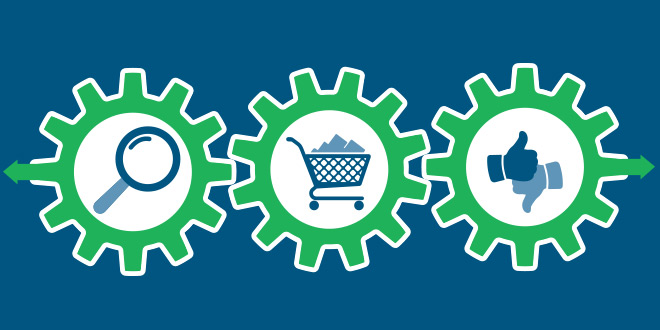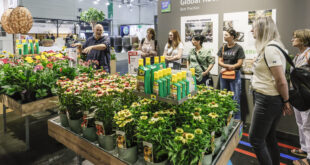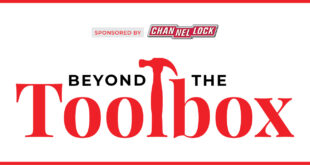To view a PDF of this story, click here.
By Renee Changnon, rchangnon@nrha.org
How to Find and Promote Trending Items
Customers walking through Ambridge Do it Best know they can find what they need to complete any project. However, they can also pick up coffee, a jar of pasta sauce and a Pittsburgh Steelers hat. David Strano, co-owner of the business, is passionate about adding new products. To do this, he follows a three-step process: discover a new item, stock and showcase it and then decide whether to keep it or move in a new direction.
His own personal drive to discover new things and share them with others has helped the Ambridge, Pennsylvania, independent business avoid becoming stagnant.
“As a business owner, I always make sure I’m in tune with the new products my customers might want or need,” Strano says. “For me, it’s important to take risks with new products and believe in those risks. If it doesn’t work, I can change my strategy and try again. But offering new things is what our customers have come to know and appreciate about our business.”
As most retailers know, finding trends or trying out new products is just as important as stocking core items. And while adding new products comes with a risk, if you feel confident there is a need for that product, it’s a risk worth taking.
Phases of the Life Cycle
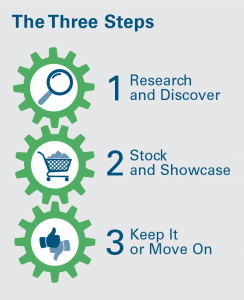 In this article, Hardware Retailing highlights the different phases of the life cycle of new products and discusses best practices for each of these phases. For Strano and other retailers, the new products life cycle is made up of three distinct phases: product discovery, stocking new products and then keeping a winner or eliminating a poor-selling product.
In this article, Hardware Retailing highlights the different phases of the life cycle of new products and discusses best practices for each of these phases. For Strano and other retailers, the new products life cycle is made up of three distinct phases: product discovery, stocking new products and then keeping a winner or eliminating a poor-selling product.
And although many new products retailers introduce in their stores may be considered niche products or categories, this cycle can be applied to a standard category’s latest item or niche product lines.
Read on to learn how Strano stays on top of the trends to keep his store full of new and interesting products and discover ways you can take risks and try new products and product niches in your business as well.
Then, click here to learn about how a buyer from one of the hardware co-ops finds and sources new items and trends to help retailers in their products search.
Research Discovery
Before a new product makes its way onto the shelves of Ambridge Do it Best, Strano has either heard of it from a customer or discovered it at a competitor’s business.
For example, about five years ago, consumers’ enthusiasm for single-serve coffee was heating up. Keurig coffee makers and K-Cup pods were the hottest new items on people’s wish lists, but not all retailers were eager to jump on the trend.
Whether he visited other stores, talked to his customers, attended trade shows or simply searched online, Strano had sufficiently researched the product line and decided the interest and intrigue were worth the risk.
Instead of simply sticking to traditional coffee makers, Strano listened to his intuition and gave Keurig coffee makers, coffee pods and accessories a place in his store.

“I knew that Keurig products were something we should get into,” Strano says. “We went to our co-op’s market and started with one machine and four K-Cup flavors. Since then, it has grown astronomically.”
Today, that risk has paid off, and Ambridge Do it Best is home to one of the largest selections of K-Cup coffee flavor pods in the area, even compared to big-box retailers like Bed Bath & Beyond, Strano says.
“We have over 40 feet of K-Cups, with about 100 flavors or more; we carry all of the machines and the accessories,” Strano says. “Our display area for Keurig is in the front of the store, and we take pride in its presentation. If you put your heart into something and believe in it, it’ll pay off.”
So how can a retailer discover the next Keurig? Product discovery takes place in a variety of ways.
“Researching and discovering new products is something I feel I have a strong passion for,” Strano says. “I like to see what’s trending at other stores, at hardware shows and by simply listening to what our customers are looking for.”
While the product discovery phase is the first step in the life cycle of new products, Strano says it is something he is always thinking about. This means keeping products at the forefront at all times. Whether he’s out visiting other stores and finds something he believes his customers would like, watching a commercial on television or walking a market floor, Strano says product discovery is something retailers should always be thinking about.
Another way Strano has discovered new products to introduce to his customers is by shopping locally as often as he can and supporting those businesses if it would be a fit.
“There is a candy store about three or four miles from my business,” Strano says. “It’s a local favorite, but I figured many people probably wouldn’t make a trip all the way out there to buy a small box of candy. That’s when I thought it might be cool to sell some of their candy in our store.”
Strano called the candy shop to request to sell a small amount of its candy in his store. As customers realized it was available, he increased his volume and selection, and now Ambridge Do it Best sells several thousand dollars worth of candy each month, and even more during holidays.
If a retailer wants to expand upon their product selection, finding a local non-competitive business in the area to stock inventory from may be a great option.
If the business agrees, it can be a win-win partnership. Not only will stocking local businesses’ products add to your sales, but also it can help create a stronger relationship with local businesses.
Stock and Showcase
Strano is always compiling a mental list of all the products he’s discovered and would like to test. However, the next phase in the life cycle of a new product requires action.
“Once we’ve discovered and decided to add a new product to our shelves, we make sure to stick to the ‘one to go, one to show,’ idea,” Strano says. “For every new item that comes in, we have to eliminate another slow-moving item. We try to be conservative with our inventory orders, but since we have a truck that comes once a week, if something does extremely well, we can increase our order moving forward.”
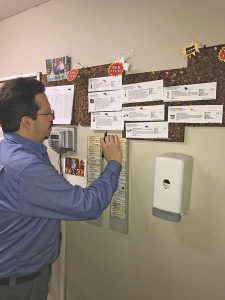
In order to make sure new products don’t hit the salesfloor and start collecting dust, Strano is proactive in communicating these new products to employees and customers.
After new products arrive and find their place in the store, Strano has images of these products and some information about them displayed on a new product corkboard in the employee break room.
“I have over 50 employees working here, so I always make sure to spread awareness for the new products we introduce on our salesfloor,” Strano says. “We have 53,000 SKUs, so I don’t expect them to know everything we have. However, by displaying the newer products in the break room, employees might get an idea for something a customer may need or want the next time they’re answering questions.”
To keep new products at the top of customers’ minds, Strano also is sure that whether an employee recommends something or not, they know if something is newer to their shelves.
“In each of our departments, I have a bulletin board that clearly displays 10 new items to hit that department,” he says.
Signage helps spread awareness for new products, and Strano says that if an item is new within a few months of being introduced, they include tags that say “New Item” along the shelves to attract attention.
Outside of signage, Strano says if a new niche is being tested in a retailer’s store, creating an inviting display in a high-traffic area is a great way to draw attention to the new items.
For example, he has a well-developed Pittsburgh sports team department devoted to the Pittsburgh Steelers, Pittsburgh Pirates and Pittsburgh Penguins. To keep the niche relevant, he is constantly sourcing new items and displaying them creatively.
“We got a light-up Pittsburgh Steelers hat a while back, and rather than just add it to a shelf and leave it alone, I decided to find a creative way to grab customers’ attention with it,” he says.
Strano got his employees in on the fun and had a few cashiers wear the light-up hat, as well as put one on a mannequin and make sure it was lit up from open to close, even if that meant going through a few batteries to keep it on.
“I ordered 24 of these hats to start and with an effort to attract people’s attention to them, they sold out almost immediately because I was proactive,” Strano says. “If you are excited and passionate about a product, share that with your customers, and you can’t go wrong.”
Keep It or Move On
The last phase in the life cycle of a new product requires retailers to take a look at how the new product or niche is doing and make some decisions on its fate. However, the most important thing to consider when looking at your inventory is if the product is adding to business or not.
“If an item is sitting on the shelf and collecting dust for more than a year, its time to code it as a slow item and do what you can to clear out your inventory,” Strano says. “To help move items along, we have a closeout section located at the front of our store, which features 50 to 100 items. I don’t want to tie up my inventory on something that’s not selling when there may be another new product or unique niche that could be bringing in sales.”

At Ambridge Do it Best, Strano says they keep a close watch on their inventory, and after trying creative merchandising options and marketing tactics to draw customers to a new product or product line, if it simply isn’t selling, they will eliminate the product.
“You need to be proactive and get rid of items that aren’t moving. However, failing at a product or product line isn’t a bad thing—it helps you learn and grow as a retailer.”
While Strano says he has failed at a few niches or products he’s tested out in his store, he stresses that a retailer will never know how something will go if they don’t try.
“You have to put time into research, put marketing tactics into place and take advertising and displaying the product in your store very seriously,” he says. “Sometimes I may want to try something out and it doesn’t come to fruition, but my goal is to try.”
The life cycle of a new product is an ongoing process, which means you can be in several phases of several cycles at once. Through any phase, Strano makes it a point to always look for new products, try them out and keep or kick them to the curb, because as online retailers compete with brick-and-mortar retailers, stocking new and cool products is vital.
“As an independent retailer, it’s more important than ever to be different than the competition. By stocking new and unique products, customers will have more reasons to return to your store instead of buying an item online from Amazon.”
 Hardware Retailing The Industry's Source for Insights and Information
Hardware Retailing The Industry's Source for Insights and Information



